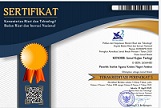Spiritualitas Makan Bersama: Interkoneksi Sesama Ciptaan dalam Praktik Pemeliharaan Alam
Abstract
Eating together is a culture that was born along with human civilization. Eating together becomes a symbol in both religious and cultural rituals. Christianity notes that eating together becomes a medium in spreading the gospel that Jesus and His disciples did. The symbolic meaning presented in the practice or culture of eating together is acceptance and fellowship. Acceptance is defined as a space to acknowledge the equality of fellow human beings, which creates a sense of solidarity. At the same time, the fellowship provides space to connect. In addition, eating together fulfills the body's physical needs for hunger and restores the freshness of the soul from fatigue. This article tries to connect symbols in eating together to present spirituality in viewing other creations, namely nature that has been damaged. Natural damage needs to be seen as a reality that must be faced and resolved t in the spirituality of eating together. Another creation is nature being the poor, oppressed, marginalized and sick. The solidarity presented in the moment of eating together becomes a new perspective in seeing the context of the destruction of nature and the awareness to build the disconnected interconnection of fellow creations.
Abstrak
Makan bersama merupakan budaya yang lahir seiring dengan peradaban manusia. Makan bersama menjadi simbol baik dalam ritual keagamaan maupun budaya. Kekristenan mencatat bahwa makan bersama menjadi sebuah media dalam mengabarkan Injil yang dilakukan Yesus dan para murid-Nya. Makna simbolik yang dihadirkan dalam ritual atau budaya makan bersama adalah penerimaan dan persekutuan. Penerimaan diartikan sebagai sebuah ruang untuk mengakui adanya persamaan terhadap sesama manusia yang menimbulkan rasa solidaritas. Sedangkan persekutuan memberikan ruang untuk saling terhubung satu dengan yang lain. Selain itu makan bersama tidak sekadar memenuhi kebutuhan fisik tubuh akan rasa lapar tetapi juga mengembalikan kesegaran jiwa akan rasa lelah. Artikel ini mencoba menghubungkan simbol-simbol dalam makan bersama untuk menghadirkan spiritualitas dalam memandang ciptaan lain yaitu alam yang telah rusak. Kerusakan alam perlu dipandang sebagai sebuah kenyataan yang harus dihadapi dan diselesaikan bersama dalam spiritualitas makan bersama. Ciptaan lain yaitu alam menjadi yang miskin, tertindas, tersingkir dan sakit. Solidaritas yang dihadirkan dalam momen makan bersama menjadi sebuah perspektif baru dalam melihat konteks kerusakan alam dan kesadaran untuk membangun interkoneksi sesama ciptaan yang terputus.
Keywords
Full Text:
PDFReferences
Farb, Peter, and George Armelagos. 1980. Consuming Passions: The Anthropology of Eating. Houghton Mifflin.
Fischler, C. 1988. “Food, Self and Identity.†Social Science Information 27 (2): 275–92. https://doi.org/10.1177/053901888027002005.
Fischler, Claude. 2011. “Commensality, Society and Culture.†Social Science Information 50 (3–4): 528–48. https://doi.org/10.1177/0539018411413963.
Herusatoto, Budiono. 2000. Simbolisme Dalam Budaya Jawa. Cet. 3. Yogyakarta: Hanindita.
Jenkins, Willis. 2008. Ecologies of Grace: Environmental Ethics and Christian Theology. New Yorks: Oxford UNiverosty Press, Kandou, Grace D. 2009. “Kebiasaan Makan Makanan Etnik Minahasa Provinsi Sulawesi Utara,†2, 3.
Kerner, Susanne, Cynthia Chou, and Morten Warmind. 2015. Commensality: From Everyday Food to Feast. Bloomsbury Academic. http://gen.lib.rus.ec/book/index.php?md5=95a2baabef329781cea34c61fd5fc9db.
Miller, J Vincent. 2017. The Theological and Ecological Vision of Laodato Si: Everything is Connected. Chennai: Bloomsbury T & T Clark, 11Shepherd, Andrew. 2014. The Gift of the Other: Levinas, Derrida, and a Theology of Hospitality.
Phil, Erari Karel. 2017. Spirit Ekologi Integral: Sekita Ancaman Perubahan Iklim Global dan Respons Perspektif Budaya Melanesia. Jakarta: PBK Gunung Mulia, 122.
Russel, M. Letty, at.all. 1998. Inheriting Our Mothers’ Garden: Feminist Theology in Third World Perspective. Lousville: The Westminster Press, 153
Sinta. n.d. “Sejarah Pengucapan Syukur Di Minahasa - Penelusuran Google.†Accessed December 11, 2018. sinta.ukdw.ac.id/sinta/resources/sintasrv/getintro/01120040/.../intro.pdf.
Smith, William Robertson. 1894. Lectures On the Religion of the Semites, First Series, The Fundamental Institution. 1st. London: Adam and Charles Black.
———. 1995. Lectures on the Religion of the Semites.: Second and Third Series ((Journal for the Study of the Old Testament Supplement Ser.; Vol. 183)).
http://gen.lib.rus.ec/book/index.php?md5=D1A5C491154EBAECAB635096FF16FE9C.
Spinks, Bryan D. 2013. Do This in Remembrance of Me: The Eucharist from the Early Church to the Present Day. SCM Studies in Worship and Liturgy. London: SCM Press.
Susanti, Rina Dewi. 2017. “Tradisi Kenduri Dalam Masyarakat Jawa Pada Perayaan Hari Raya Galungan di Desa Purwosari Kecamatan Tegaldlimo Kabupaten Banyuwangi (Kajian Teologi Hindu).†Institut HIndu Dharma Nusantara, 2, 1.
Waluyo, Muhamad Edy. n.d. “NILAI-NILAI DAN MAKNA SIMBOLIK TRADISI NGANGGUNG,†15.
DOI: https://doi.org/10.37196/kenosis.v7i2.331
Refbacks
- There are currently no refbacks.
Copyright (c) 2021 KENOSIS: Jurnal Kajian Teologi

This work is licensed under a Creative Commons Attribution-NonCommercial-ShareAlike 4.0 International License.
Jurnal Kenosis Telah Terdaftar Pada Situs:
This work is licensed under a
Creative Commons Attribution-ShareAlike 4.0 International License.
Copyright © Kenosis: Jurnal Kajian Teologi 2015-2022. All Rights Reserved.



